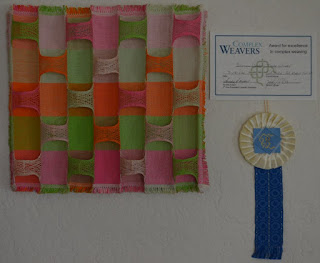Fall, leaves, fall; die flowers, away;
Lengthen night and shorten day;
Every leaf speaks bliss to me
Fluttering from the autumn tree.
- Emily Bronte
- Emily Bronte
For our Guild's challenge for 2012, last spring we each chose a paper bag and got a card with these rules to follow:
1. use at least 50% green
2. use a twill and/or tabby weave
3. incorporate a circle
4. may be folded, bent etc. and must fit inside and be returned in the bag/sack
5. the size of the sack you choose will determine your entry size
Here's my finished project which I turned in last weekend:
I wanted to try some warp painting, using sprang to form a frame for my painting. I untensioned the dark green warps and pushed them aside. You can see at the bottom of the image that I should have either stopped weaving sooner before starting to paint, or else rotated my image so that it didn't overlap fabric already woven:
I used fluid acrylic paint, thinned with GAC 900 medium which is meant for fabric painting. I found this much easier to control than when I've tried to paint with regular dye. The finished feel of the fabric is a little stiff, but since the finished product isn't meant to be worn or touched and just stays in two dimensions, I think it works fine. Underneath the warp I used a laminated placemat to provide a surface against which to press the brush and yarn.
After the paint dried throughly, I resumed weaving. I really liked what the woven twill pattern was doing to the colors in my image:
As you can guess, this is why I was experimenting earlier to see if I could do sprang using weft as well as warp. Here's the sample I was working on:
The major purpose of the sample was to see if I had the proportions right to make the four sprangwork curves form a circle. You can see above that I didn't. So in the final piece I expanded the middle section to make the curves longer.
One thing I learned in this project that was exciting is the relationship between the simple twills I used. The 3/1 twill in the corners, when every 4th warp is lifted out and left unwoven, becomes a 2/1 twill. And when every 4th weft is either omitted or left unwoven, it becomes a little 2/1 point twill.


















































